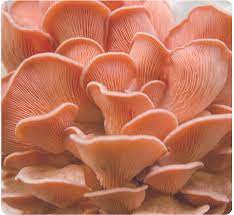Pink Oyster Mushrooms (Pleurotus djamor) are not only a delight to the palate but also a fascinating addition to home and commercial mushroom cultivation. Their vibrant pink color and unique appearance make them a popular choice among mushroom enthusiasts. To successfully cultivate these mushrooms, understanding and providing the ideal growing conditions is crucial. In this guide, we will delve into the various factors that contribute to the optimal growth of Pink Oyster Mushrooms.
2. Choosing the Right Substrate
The substrate, or growing medium, plays a vital role in the successful cultivation of Pink Oyster Mushroom. These mushrooms are known for their ability to thrive on a variety of substrates, including straw, sawdust, and agricultural by-products like corn cobs or cottonseed hulls. However, a mix of straw and hardwood sawdust is commonly recommended for optimal results.
Ensure that the substrate is properly sterilized before use to eliminate any competing organisms that might hinder mushroom growth. Sterilization can be achieved through methods such as steam pasteurization or pressure cooking.
3. Optimal Temperature and Humidity
Temperature and humidity are critical factors in the cultivation of Pink Oyster Mushrooms. These mushrooms flourish in warmer conditions compared to some other varieties. The ideal temperature for their growth ranges between 75-80°F (24-27°C). Maintaining a stable temperature within this range promotes the mycelium’s colonization of the substrate and encourages the formation of fruiting bodies.
Humidity levels are equally crucial. Pink Oyster Mushrooms thrive in high humidity, typically around 90-95%. To maintain these conditions, consider using a humidifier or regularly misting the growing environment. Adequate humidity ensures proper development and prevents the mushrooms from drying out.
4. Lighting Requirements
While Pink Oyster Mushrooms do not require direct sunlight for growth, they do benefit from indirect light. Natural light or fluorescent bulbs with a color temperature of around 6500K can simulate daylight and encourage the formation of mushroom pins. However, excessive light can lead to drying, so it’s essential to strike a balance and monitor light exposure.
A 12-hour light-dark cycle is commonly recommended during the initial stages of growth. Once the mushrooms start developing, reducing the light duration to 8 hours per day is usually sufficient.
5. Ventilation and Air Exchange
Proper ventilation is crucial to ensure a continuous supply of fresh air and the removal of carbon dioxide produced during the mushroom growing process. Adequate air exchange prevents the buildup of harmful gases and promotes healthy mushroom development.
Consider installing a ventilation system or manually fan the growing area multiple times a day. Maintaining a good airflow pattern helps prevent issues like contamination and ensures the Pink Oyster Mushrooms receive the oxygen they need to thrive.
6. pH Levels for Pink Oyster Mushrooms
Maintaining the correct pH level in the substrate is essential for Pink Oyster Mushroom cultivation. These mushrooms prefer slightly acidic to neutral conditions, with a pH range of 6.0-7.5 being optimal. Regular monitoring of pH levels throughout the cultivation process is recommended, and adjustments can be made using pH-balancing agents if necessary.
7. Harvesting and Storage Tips
Pink Oyster Mushrooms are typically ready for harvest when the caps have fully opened but before the gills are exposed. Harvesting at the right time ensures the best flavor and texture. Use clean, sharp scissors or a knife to cut the mushrooms at the base of the stem.
For storage, place harvested Pink Oyster Mushrooms in a paper bag or a breathable container in the refrigerator. Avoid sealing them in plastic bags, as this can lead to moisture buildup and spoilage.
8. Common Challenges and Solutions
Like any cultivation endeavor, growing Pink Oyster Mushrooms comes with its challenges. Common issues include contamination, slow growth, and abnormal fruiting. To address these challenges, maintain strict cleanliness protocols during substrate preparation and inoculation, ensure optimal environmental conditions, and troubleshoot as needed. Consulting with experienced growers or mycologists can provide valuable insights into specific challenges encountered during the cultivation process.
Welcome to Lone Star Mushrooms, where passion meets cultivation to bring you the finest and freshest mushrooms nature has to offer. Nestled in the heart of [imaginary region], Lone Star Mushrooms is a family-owned farm dedicated to delivering premium quality mushrooms to your table.
9. Conclusion
Cultivating Pink Oyster Mushrooms can be a rewarding and enjoyable experience when the ideal growing conditions are provided. By carefully selecting the substrate, controlling temperature and humidity, managing lighting and ventilation, and addressing other key factors, growers can increase their chances of a successful harvest. Regular monitoring, attention to detail, and a willingness to troubleshoot issues contribute to a thriving Pink Oyster Mushroom cultivation project. With the right knowledge and dedication, you can enjoy the delightful taste and vibrant appearance of these unique mushrooms right from the comfort of your home or as part of a commercial venture.



